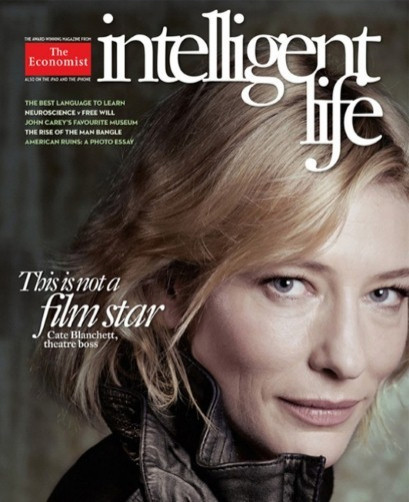Cate Blanchett Cover Of Intelligent Life Completely Photoshop-Free [PHOTO]

Cate Blanchett might have just made history. The 42-year-old A-list actress appears on the cover of Intelligent Life magazine and the photo is (shockingly) completely Photoshop-free.
Cate Blanchett appears on the cover of the March/April issue of Intelligent Life, a bi-monthly lifestyle and culture publication under the Economist, showing off her natural, unaltered beauty. Posing in a black leather jacket with her head turned over her right shoulder, Blanchett looks noticeably stunning and noticeably untouched. In a world of Photoshop-mania, where people can literally be morphed into someone unrecognizable with the use of a digital platform, Blanchett's cover is a striking move in the opposite direction.
Intelligent Life's editor Tim de Lisle explained why he made the choice to put actress Cate Blanchett's un-Photoshopped portrait on the cover on his blog: When other magazines photograph actresses, they routinely end up running heavily Photoshopped images, with every last wrinkle expunged. Their skin is rendered so improbably smooth that, with the biggest stars, you wonder why the photographer didn't just do a shoot with their waxwork, wrote Lisle.
Cate Blanchett, by contrast, appears on our cover in her working clothes, with the odd line on her face and faint bags under her eyes. She looks like what she is - a woman of 42, spending her days in an office, her evenings on stage and the rest of her time looking after three young children.
We can't be too self-righteous about it, because, like anyone else who puts her on a cover, we are benefiting from her beauty and distinction, he added. But the shot is at least trying to reflect real life. It's a curious sign of the times that this has become something to shout about.
Cate Blanchett's cover shocked and awed many.
Blanchett and Intelligent Life should be applauded for this cover. (De Lisle is quick to point out that the magazine can't be too self-righteous about its decision because they are benefiting from [the actress's] beauty and distinction.), wrote Washington Post writer Sarah Anne Hughes.
That's not to say that magazine covers or ad campaigns featuring famous people that have been retouched are necessarily bad. But seeing a celebrity look like - gasp - an actual person in a photograph like this is refreshing. A dose of reality can do wonders for a person's self-esteem.
In an age where Photoshop reigns kings, seeing a middle-aged, A-list actress appear without the use of it is truly fantastic.
Just this week, photos of Victoria's Secret Angels and other supermodels without makeup began circulating the internet once again. The photos were used as the casting of Louis Vuitton's Fall/Winter 2010 show. The casting shots showed supermodels like Rosie Huntington-Whiteley, Bar Refaeli, Adriana Lima, Alessandra Ambrosia and more without any makeup on.
From magazines to the runway, supermodels appear effortlessly flawless. That's why their stripped down off-duty looks are often more jarring than smoky-eye and bronzer could ever be, wrote Tara Aquino of Complex magazine. We're so used to seeing these women look a million times more attractive than the average human that it feels unnatural when they resemble someone regular. For the record, we think these supermodels are beautiful no matter what, but these 30 Shocking Photos of Supermodels Without Makeup definitely caught us a little off-guard.
The mystique that comes with celebrity surely has something to do with it. Celebrity worship is common in Western culture as actors, musicians and models are made gods. Over-saturation of coverage makes them a part of daily life.
In our society, celebrities act like a drug, James Houran, a psychologist at the consulting firm HVS Executive Search who helped create the first questionnaire to measure celebrity worship, toldLiveScience.They're around us everywhere. They're an easy fix.
According to others, the reason for celebrity obsession lies in biology. There's a few different reasons for that, Daniel Kruger, an evolutionary psychologist at the University of Michigan, told LiveScience. One is just learning what high-status individuals do so you might more effectively become one, and two, it's basically political. Knowing what is going on with high-status individuals, you'd be better able to navigate the social scene.
It is this mystique coupled with the celebrity-equals-deity mentality that make such personages and imagery of them so powerful.
The obsession can turn dangerous when young girls compare themselves to the made-up and airbrushed images seen in advertisements and in magazines. Findings suggest that in female adolescents, there is an interaction between Intense-personal celebrity worship and body image between the ages of 14 and 16 years, and some tentative evidence has been found to suggest that this relationship disappears at the onset of adulthood, 17 to 20 years, according to a 2005 study by L. Maltby.
Israel enacted a law on Monday that bans too-skinny models from working unless they meet a specific body mass index (BMI). The skinny model ban also prohibits the use of models who look underweight in advertisements, reported Yahoo! News. Developers of advertisements in Israel must disclose whether or not they used Photoshop or digital alterations to make the model look thinner.
In Israel, approximately two percent of girls between the ages of 14 and 18 have severe eating disorders, according to a study by anthropologist Sigal Gooldin. We want to break the illusion that the model we see is real, Liad Gil-Har, assistant to law sponsor Dr. Rachel Adato, told the New York Daily News.
So, a photo of a supermodel or a celebrity without makeup becomes a sort-of counteroffensive to this unattainable notion of flawlessness, since those who are supposed to embody the highest standard of perfection do not even meet it themselves.
© Copyright IBTimes 2024. All rights reserved.





















